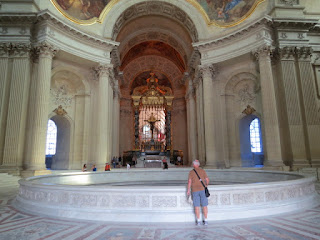Les Invalides is a Paris attraction I was not familiar with before coming here.
But it is a place I thoroughly enjoyed visiting.
Les Invalides is a complex of buildings containing museums and monuments.
The vast Musee de l'Armee is here. This is a French Army museum- the French Army museum, I think it's safe to say.
The brochure provided to visitors says the museum holds and displays one of the world's richest collections of military objects and history.
There is room after room of armor.
"These piece are displayed in chronological order," the brochure states, "recalling the knights from the time of Saint Louis up to the permanent army of the 17th century."
There are also extensive displays of arms and armor from other parts of the world, hunting arms and tournament arms.
The military collections extend from the Middle Ages to the Napoleonic Wars, Franco-Prussian War, and World Wars I and II.
I had read about Invalides having an extensive armor collection throughout history, so I was expecting to see more tanks.
This was the only full size tank I saw.
There are some enlarged photographs of tanks, such as this one of German armor rolling into France in 1940.
There is a good representation of artillery during the ages.
There are many cannon and other heavy guns.
Military uniforms from all eras and French wars are expertly depicted.
The French Army Museum boasts having more than 500,000 "arms, armours, artillery pieces, decorations, emblems, paintings and photographs."
The complex dates to 1676. King Louis XIV wanted a hospital and home for wounded and unwell soldiers, hence the "invalides" name.
I found this a neat feature of the exterior design, these big knights in armor outside the roof level windows, framing the windows in a very martial way.
Inside is a huge courtyard or parade grounds.
A special treat on June 21 when I visited this museum was that is was World Music Day.
I got to see this military band perform. This image is panorama taken with my iPhone 7.
The performance began soon after I arrived.
It was really hot on this day. I felt for the men being exposed to the midday sun and heat.
But they were very professional and kept their cool- as much as they could!
The performance was excellent!
The outside areas adjoining the courtyard have more artillery.
Some of the engravings on the cannon are very artistic.
You can see the engravings more clearly in this photo (click on the image to enlarge).
For me, one of the most memorable items at this military museum is this chart showing, by country, the number of soldiers, sailors and other military personnel who died in World War II.
This death toll was 50 million, plus another 30 million civilians. "Allemagne" is Germany, by the way.
Admission to Les Invalides (12 euros for adults) also gives access to the beautiful gold domed church which houses the tomb of Napoleon Bonaparte.
This royal chapel, called today both the Cathedral (or Church) of Saint-Louis and the Dome Church, was built from 1677 to 1706.
The altar is opulent. "The interior decorations produced at the time glorify Louis XIV, his monarchy and armies," according to the Les Invalides website.
Louis XIV was fond of gold! The SL between the cherubs stands for Saint Louis.
Napoleon's massive tomb is in the royal chapel. It can be viewed from two different levels.
Napoleon died in 1821 while exiled on St. Helena Island in the South Atlantic Ocean.
This is the view inside the Dome Chapel. Napoleon's Tomb is one level down. The man here is looking down at it. Visitors take stairs to see it at eye level (photo above).
The tomb is beautifully displayed in an oval setting. It is surrounded by sculpted female figures.
Napoleon was buried on St. Helena Island until 1840. King Louis-Phillipe decided to bring home his ashes.
They were placed at Les Invalides during a state funeral. It would be 1862 when the tomb was completed and Napoleon's remains were placed in this grand and elegant sarcophagus.
The Dome Church also has a crypt for Napoleon II. He was the son of Napoleon Bonaparte.
An interesting fact, according to Wikipedia, is that Adolf Hitler in 1940, after conquering France, had Napoleon II's remains moved from Austria to here at Les Invalides.
His remains were first buried next to his father's, but after the war would be moved to another corner of the crypt area.
French World War I leader, Gen. Ferdinand Foch, is also interred near the Napoleons.
His tomb is powerful in the sense of the large sculpture atop the sarcophagus depicting Foch's body being carried by several of his soldiers.
As if the French Army Museum and Napoleon's Tomb were not enough history and culture for one Paris location, Les Invalides also includes the beautiful Cathedral of Saint-Louis.
The church dates to 1676. It was designed for the military veterans and wounded who lived in the "Hotel des Invalides," which, again, was the complex' original purpose.
Les Invalides is a treasure of French history, culture and aesthetics. I will always treasure my experience visiting such an incredibly interesting place!





































No comments:
Post a Comment